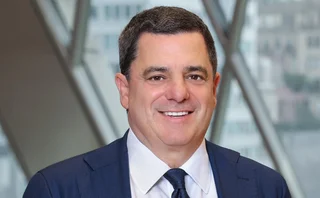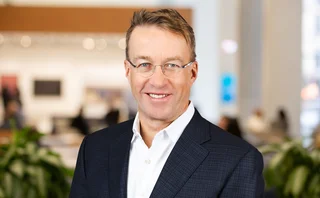
Best specialist sub-$250m FoHF over 15 years: Culross Arbitrage Fund (Culross Global Investment Management)
Imperfect markets create opportunities for Culross, played out through different themes

European Fund of Hedge Funds Awards 2016
Two funds dominate Culross Global Investment's offering. The Arbitrage Fund focuses purely on arbitrage strategies in a specialist vehicle, while the Global Fund takes a broader view, reflecting whether the firm is optimistic, neutral or pessimistic about arbitrage activity, notes Nigel Blanshard, founder of Culross and head of the investment team.
While these two funds exploit hedge fund strategy investment themes, over a 15-year period they have produced solid returns for investors. The Global Fund has returned 155.58% over 15 years with a downside volatility of 1.94%, while the specialist Arbitrage Fund has given investors close to 100% with downside volatility of 1.61% over the same period.
Behind this success is careful manager selection, reflecting the market views of Blanshard and his colleagues.
The Arbitrage Fund is invested in one super theme and drills down into specific strategies: merger, fixed income, diversified event driven, instruments and mortgages, as well as what Blanshard terms "bear risk hedgers".
"Our view has always been that markets are never perfect and therefore opportunities to arbitrage something is always there," says Blanshard. "But markets are cyclical even in that world. This means at times there are tremendous arbitrage opportunities and the opposite. That cycle is the one we try to gauge and run the fund to profit from."
Looking at merger arbitrage, Blanshard sees some risks mounting on the horizon.
"When everyone can borrow to the max to load up these strategies, that's arguably a dangerous time," cautions Blanshard. "Strategies will reach the danger point in the cycle of profitability and shortly thereafter peak in profitability. The tendency is to chase what worked yesterday but the momentum isn't there anymore."
At present, spreads are unusually wide, even exceptionally wide, with a surprising number of trades broken for government intervention reasons.
The tendency is to chase what worked yesterday but the momentum isn't there anymore
Nigel Blanshard
One example of this was the German government consenting to the Chinese acquiring a German corporation. The regulator reversed the permission only two weeks later. This is the first time this has happened. That event created a level of fear in the market that is not normal: fear of regulatory intervention and deals breaking because of that.
Given that merger arbitrage is usually one of the larger allocations within the specialist fund, such events are a signal to consider options.
Fixed-income arbitrage, in particular, is blessed with both great opportunities and great risks. This is a world of government bonds versus futures contract basis trading, coupled with box trades along the government bond curve. That has been and will continue to be a permanent source of profits for the fund, says Blanshard. However, in the past most of these trades were carried out in banks by proprietary traders. Today, that has changed. The payout has gone up and the willing capital pool is smaller. "However, this pool is sufficient to play that arbitrage strategy and keep the related component connected in price. So government bond fixed income is a very interesting space. There are few long-standing specialists who have been practicing these trades for 20-30 years. What they do today is what they did 10 years ago. They are money-making machines," says Blanshard.
The main risk in this area is excessive leverage. "Today it's hard to find an investor running a highly leveraged government bond portfolio. Leverage is not the risk, but rather a market manipulated by central banks and governments. That's something of a risk, but I don't think sufficient to be a large deterrent," notes Blanshard. He says this area is still an "interesting space" for the fund and points out that, over the past 12 months, the best-performing manager in the fund was a fixed-income arbitrage manager.
Related to this area is credit arbitrage, where the game is not pitching one bond against another, but where the credit index arbitrages against a pool of reference names. Each credit index has 125 pool reference names and those bonds trade in the cash market. The index is that pool. The driver of the index price and cash prices are not the same, so there are sufficient disconnects to mean that capital can take advantage of the differences. "The nearest thing to a free lunch in arbitrage," says Blanshard.
This is an area where a number of French managers are particularly strong. Blanshard says they are known for liking detail, a systematic approach and understanding nuances. "We have one manager in Paris and he is a master of the craft."
'Bear risk hedges'
Over the next 12 months, Blanshard's worries are mainly on the merger arbitrage area. "When a bid is made for cash and the trade can't be set up as a long/short equity arbitrage, that introduces a different risk into the transaction because the merger arbitrage is long the target, assuming it will reach completion. However, if between now and completion there were some terrible market dislocation, these prices can get dragged down with the collapsing market, even though the buyer has not changed anything," he explains.
This is the one of the primary drivers for the bear risk hedge component in the portfolio. "If that merger arbitrage risk becomes manifest, bear risk managers make money to cancel out losses coming from the merger arbitrage space."
Another challenge he sees coming is a "heavy duty sell-off" in equities or fixed income infecting other asset classes with rising volatility. "When volatility goes up, arbitrage spreads and relationships become more volatile and spreads widen. That's a formula for losing, not making, money."
To explain the environment, Blanshard uses a sailing metaphor. "Arbitrage is an activity that works well in good sailing conditions. You make a lot of money if there is a brief storm. But when the storm reaches Force 9, get out and stay out," advises Blanshard. In such markets there will be severe dislocation – like in 1998 – as well as liquidity problems. Although the scenario has a low probability attached to it, the fund tends to "batten down the hatches" well before any storm arrives.
When volatility goes up, arbitrage spreads and relationships become more volatile and spreads widen. That’s a formula for losing, not making, money
Nigel Blanshard
For present, the arbitrage fund is sticking with its current set of managers. In fact Blanshard says managers in the fund are not changed frequently, although the weightings to the different strategies can be changed "very dynamically" month-to-month and quarterly. "Liquidity matters. We want managers who have no gates or locks and monthly terms."
If merger spreads begin to tighten meaningfully in 2017, the weighting to that strategy will decrease. If government bond markets continue to jump around, that allocation will rise. "We've got a good allocation to bear risk at present, sufficient protection for the risks we can see," he concludes.
The fund has the flexibility to add a macro hedge from zero up to 40% "if the world is visibly coming to a stop. That's why we have the bear risk hedges," he says. "Bear risk hedges are our way of describing a community of macro managers, be they discretionary or quantitative, who are either slightly or extremely suspicious of the current state of affairs, mildly or aggressively positioning for corrections in capital markets, be that in interest rates and/or equities and/or foreign exchange, commodities – anything. When one breaks, the rest usually follow," he says.
To keep on top of market views and allocation adjustments within the fund, Culross speaks at least once a month and sometimes more frequently to all its managers. "We may just have a three-minute conversation weekly about exposures. Any thing we see that is unexpected in the manager, we will talk about it, usually by email as written answers give a record of what they said and less scope for getting it wrong," explains Blanshard.
Staying in contact with managers is important, according to Blanchard. It helps his team understand market views and what is happening on the ground as well as keep an eye on their own investments. There is a formal face-to-face meeting with managers every four months where Culross quizzes them about the business, markets, any positioning changes and other trading matters.
The whole investment team undertakes the theme selection and allocation process. Theme sourcing is the basis of the process with constant monitoring and assessment of macroeconomic, market and political development. The decision to implement a theme is taken at investment committee meetings. While the time horizon for each theme varies, the average time invested in one theme is usually two years. This strategy for Culross has shown a proven ability to adapt to changing macro and market environments, allowing dynamic reallocation among the investment themes.
Culross Global Fund won best diversified sub-$250m FoHF over both 10 years and 15 years.
Only users who have a paid subscription or are part of a corporate subscription are able to print or copy content.
To access these options, along with all other subscription benefits, please contact info@risk.net or view our subscription options here: http://subscriptions.risk.net/subscribe
You are currently unable to print this content. Please contact info@risk.net to find out more.
You are currently unable to copy this content. Please contact info@risk.net to find out more.
Copyright Infopro Digital Limited. All rights reserved.
As outlined in our terms and conditions, https://www.infopro-digital.com/terms-and-conditions/subscriptions/ (point 2.4), printing is limited to a single copy.
If you would like to purchase additional rights please email info@risk.net
Copyright Infopro Digital Limited. All rights reserved.
You may share this content using our article tools. As outlined in our terms and conditions, https://www.infopro-digital.com/terms-and-conditions/subscriptions/ (clause 2.4), an Authorised User may only make one copy of the materials for their own personal use. You must also comply with the restrictions in clause 2.5.
If you would like to purchase additional rights please email info@risk.net
More on Awards
Market liquidity risk product of the year: Bloomberg
Bringing clarity and defensibility to liquidity risk in a fragmented fixed income market
FRTB (SA) product of the year: Bloomberg
A globally consistent and reliable regulatory standardised approach for FRTB
Best use of cloud: ActiveViam
Redefining high-performance risk analytics in the cloud
Best use of machine learning/AI: ActiveViam
Bringing machine intelligence to real-time risk analytics
Collateral management and optimisation product of the year: CloudMargin
Delivering the modern blueprint for enterprise collateral resilience
Flow market-maker of the year: Citadel Securities
Risk Awards 2026: No financing; no long-dated swaps? “No distractions,” says Esposito
Pricing and analytics: fixed income – Quantifi
Quantifi delivers high-performance, transparent and adaptable pricing and risk analytics for fixed income and credit markets
Derivatives house of the year: Citi
Risk Awards 2026: Rev up, RWAs down, as US bank gets back on track (with added XiNG and XiP)







